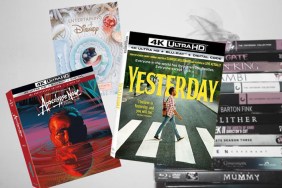When we last left off in The Series Project, we had just concluded talking about the second film in The Prophecy series, which was, fittingly enough, called The Prophecy II. To briefly reiterate the conclusions I had already come to: The Prophecy is a rather good, solid genre picture, and The Prophecy II takes a hard left turn into schlock. Surprisingly – as the series progresses into parts three, four, and five – it doesn’t really continue its downward slump, but kind of idles gently between pretty okay schlock, and not very good schlock.
The case with most long-running film series, especially horror series (as explored through the various Series Project articles), a series tends to start strong, maybe have one or two okay sequels, and then sidle quickly into worse and worse territory. With the exception of Godzilla, and maybe James Bond, no film series can really claim to bob up and down as they progress, offering both good and bad over the course of many years. Most just deteriorate. That The Prophecy sequels stay consistent (even if it’s consistently mediocre) proves to be an aesthetic strength.
The Prophecy movies were originally conceived of by Gregory Widen, the same man who wrote the Highlander movies, so the in-film myth is rather strong. Angels live amongst us, they wear black, perch like birds, don’t have visible wings, and are interested in getting back into God’s good graces – they have been largely ignored by the good Lord ever since we pesky humans came on the scene with our souls and our free will. The first three film surrounds the fate of the archangel Gabriel (Christopher Walken) who, when we last saw him, was divinely transformed into a human after one too many attempts to break back into Heaven and muck up God’s plan.
Walken will appear in one more film, concluding the story set up in The Prophecy II, and then abandon the series to a new continuity. Let us pick up with…
The Prophecy 3: The Ascent (dir. Patrick Lussier, 2000)

Patrick Lussier made Drive Angry and the remake of My Bloody Valentine. He is also the man behind Dracula 2000, so he has a pretty solid grip on trashy pulp material.
And The Prophecy 3 does feel pretty trashy most of the time. The first film felt classy, spooky, and gave several respectful nods to Christianity, and Christian angel lore (which can be researched and recorded). These later films, in true sequel fashion, begin to disappear up their own asses. The Prophecy 3, lucky, still has Christopher Walken around to class up the joint a little.
So the story picks up a good 20 years after the events of The Prophecy II. Gabriel (Walken) is still a human, has taught himself to drive, and seems perfectly content with his soul and his free will. I would love to have seen a film wherein Gabriel acclimatizes to becoming a human being, but that was already covered in 1987’s Wings of Desire, a classic film that doesn’t belong in the same essay as The Prophecy 3.

Gabriel is an ancillary player in a much larger plot, this time masterminded by a new evil angel named Pyriel (Scott Cleverdon). Pyriel has a vague scheme to kidnap a nephilim and use him to create a second Hell of his very own. Pyriel, however, spends most of the film off camera, sending his underling Zophael (Vincent Spano) to do his dirty work. A nephilim, as learned in The Prophecy II, is a half-human, half-angel hybrid that used to rule the Earth in antediluvian times.
In the last film, we saw the birth of the son of Danyael, who is also named Danyael, and is played by the simpering Dave Buzzotta. Danyael is an underground preacher of some sort who preaches about the indifference of God, and who is promptly shot by a zealot (Brad Dourif). The shooting sets in motion Pyriel’s plans to lure Danyael out to the desert and do something that will allow him to open up his own Hell. I don’t really recall the details. Zophael gets into fights and has a switchblade ninja staff. Danyael has a pretty girlfriend named Maggie (Kayren Ann Butler) who shows off her midriff a lot. There’s a scene in a donut shop where Zophael bribes the shop owner with a napkin. Angels can also hypnotize people now, just like in The Shadow. Angels also love sugary foods, which is actually something established in the 1996 angel comedy Michael, wherein John Travolta played the titular angel.

Whither Gabriel? He’s around. Walken appears in a few scenes to talk down to Zophael, and make references to the previous films. Odd that Gabriel should play such a minor role in this film. Other references to the first: Steve Hytner appears once again as the wisecracking pathologist, this time providing vital exposition. Even Moriah Shining Dove Snyder (the possessed little girl from the first film) has a cameo. There’s a scene in a diner wherein the same actress playing the same waitress questions Gabriel about Amanda Plummer from the first film. I like these little nods, even though they most often proved how limp this film was compared to the original.
The film ends with a big fight between Danyael and Pyriel in some sort of angelic other-dimension. Danyael stabs Pyriel and all is well. No hints at theology. Not much in the way of scares. Just a middling straight-to-video sequel. I guess I prefer this one to The Prophecy II, as it bothers to explore the series’ myth a little bit more, and Walken and Dourif appear.

This was intended to be the final film in the series, and some reviews I have read refer to it as “the final film in The Prophecy trilogy.” But the studio didn’t seal the series off here. Five years later, they resurrected the angels with…




